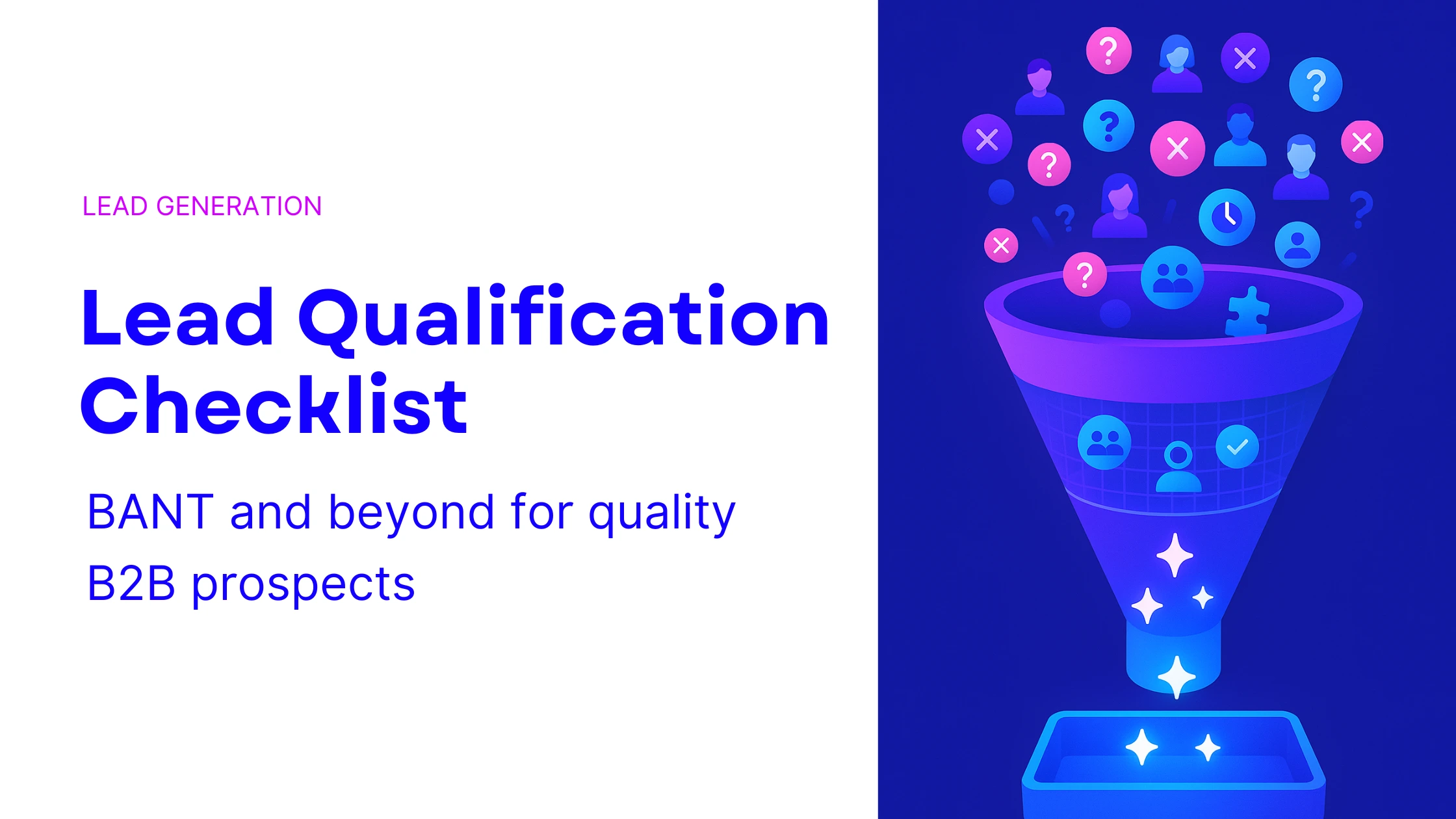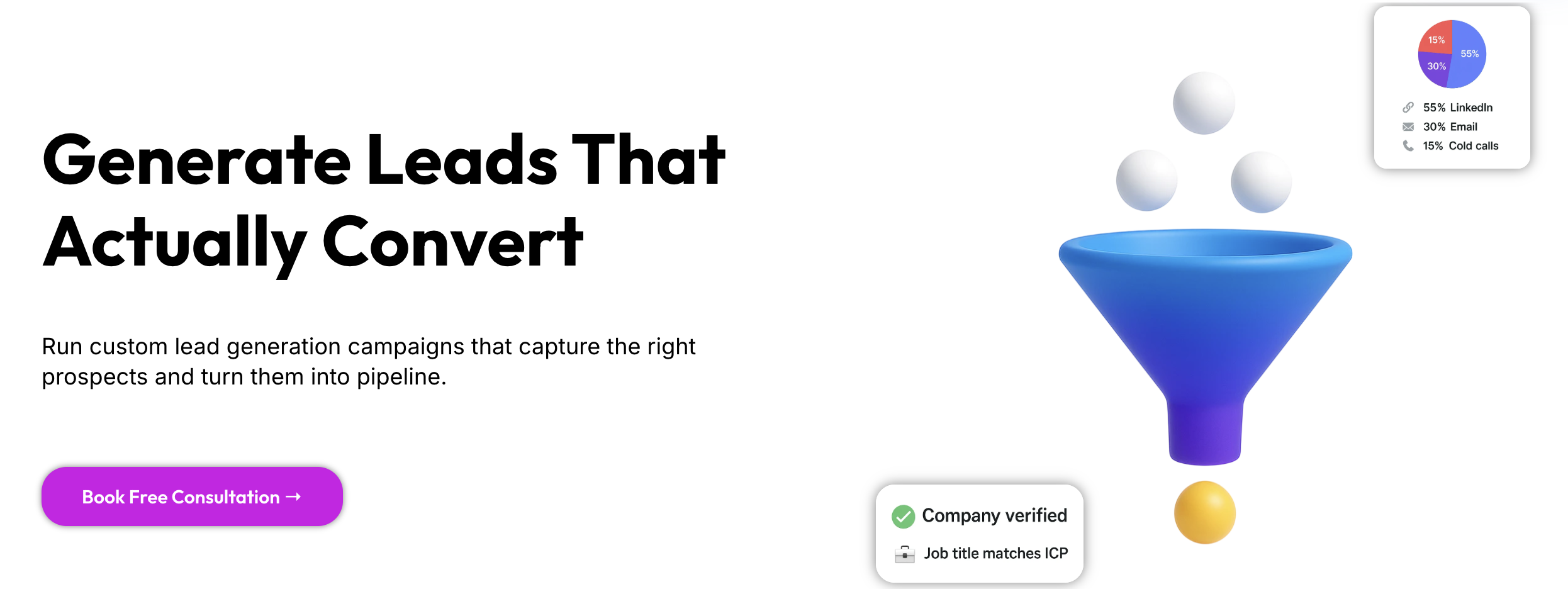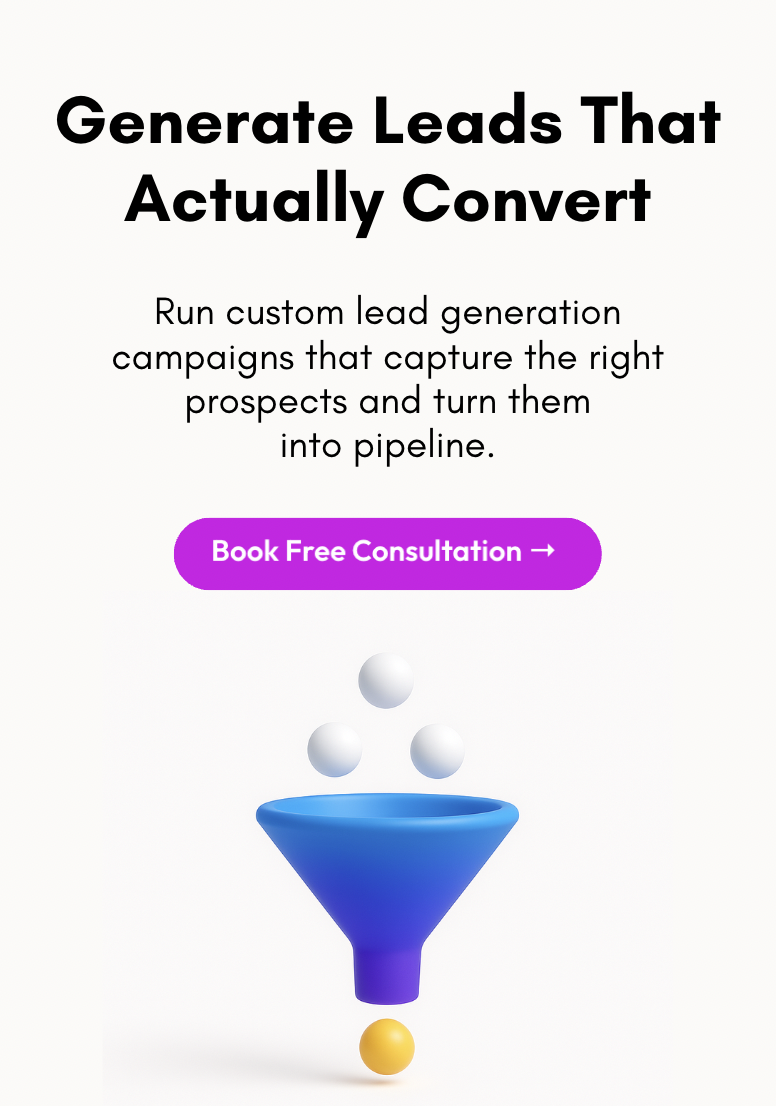Lead Qualification Checklist: BANT and Beyond for Quality B2B Prospects

📅 Published: May 27, 2025 | ⏱️ 12–14 min read
Table of Contents
- Introduction
- 1. Ask budget & spend triggers to qualify B2B leads
- 2. Identify decision-makers early in the lead qualification process
- 3. Check if the prospect has a real business need
- 4. Clarify the prospect's buying timeline and urgency
- 5. Understand your prospect's goals and challenges
- 6. Review the prospect's current tech stack or tools
- 7. Measure the prospect's engagement level with your brand
- 8. Confirm if the prospect has a buying process or RFP
- 9. Plan a follow-up strategy to keep prospects warm
- 10. Document and share lead qualification findings with your team
- 11. Focus on building good relationship with your prospects and customers alike
- What's Next?
Introduction
Ever feel like you are spending too much time on leads that go nowhere? You are not alone. Most teams waste hours chasing maybes instead of spotting real intent early.
The classic BANT framework (Budget, Authority, Need, and Timeline) is a solid starting point. But sales today is more complex. A quick yes on budget or authority doesn’t mean the deal is real. You need to go deeper to know who’s actually ready to move.
This checklist gives you 11 key qualification checks (many inspired by BANT) designed to help you focus on real opportunities. Use it to qualify faster, avoid the usual BANT traps, and spend time only on leads that are ready to buy.
1. Ask budget & spend triggers to qualify B2B leads
Budget questions are often misunderstood. It’s not just about whether they have funds right now.. it’s about how they make buying decisions and what they prioritize.
Instead of asking, “Do you have budget?” try asking how similar purchases are usually approved. If they say it isn’t budgeted yet, don’t walk away. That’s often a sign they are early in the process, and still worth nurturing.
Many teams fund the right solution using leftover budget, pilot projects, or internal reallocations. If the problem is important enough, they’ll usually find a way to pay for it.
🔍 What to look for:
Do they understand how funding works in their org, or are they still figuring it out?
Are they exploring solutions now, or just collecting info for later planning?
Do they mention cycles like quarterly reviews or annual budget resets?
💬 How to go deeper:
“How does budget approval usually work for a tool like this?”
“If it’s not funded yet, when does that conversation usually happen?”
“Is there flexibility for the right fit if the value is clear?”
2. Identify decision-makers early in the lead qualification process
Most deals slow down or fall through because someone critical was left out of the conversation. Your contact may be the one doing research, but that doesn’t always mean they control the final decision.
Instead of asking, “Are you the decision-maker?” focus on understanding how decisions are made in their company. Who influences the decision? Who approves the budget? And who could block the deal?
The goal is to map the full picture early so you are not surprised later.
🔍 What to look for:
Do they speak in terms of “I” or “we” when discussing decisions?
Are other departments or names mentioned, even casually?
Is there any hesitation when discussing next steps or sign-off?
Are they confident in the process, or do they seem unsure who gets the final say?
💬 How to go deeper:
“Who else usually weighs in before something like this moves forward?”
“What does a typical buying process look like on your side?”
“Would it be helpful if we included others early, so nothing gets stuck later?”
3. Check if the prospect has a real business need
Not all interest is tied to a real buying intent. Some leads are just curious, comparing options, or doing early research. Your job is to separate casual interest from a real problem that needs solving.
The best way to do that is by understanding the pain behind their inquiry. What’s broken? What’s costing them time, money, or growth? If the impact is small or unclear, the deal is unlikely to move forward.
Don’t just listen to what they want. Listen for why they want it, and what happens if they don’t get it.
🔍 What to look for:
Are they describing symptoms (slow workflow) or real problems (missed revenue targets)?
Do they talk about consequences- lost deals, churn, inefficiency, risk?
Are they evaluating now because something changed internally (new goal, new leadership, new pain)?
Do they have specific goals they want to hit, or are they just “exploring options”?
💬 How to go deeper:
“What happens if this issue isn’t solved in the next quarter?”
“What triggered the search for a solution now?”
“Is this something your team has tried to solve before? What happened?”
“How would solving this impact your team or business in the short term?”
4. Clarify the prospect’s buying timeline and urgency
Even when a lead seems interested, the timing might not be right. Some are ready to buy now. Others are gathering info for next quarter or waiting on internal alignment.
Your goal is to find out what’s driving the timeline. Is there a clear reason they need a solution soon, or are they just exploring? The more specific the urgency, the more real the opportunity.
A clear timeline helps you prioritize and plan next steps with confidence.
🔍 What to look for:
Are they referencing upcoming milestones like launches, audits, or team changes?
Do they mention internal deadlines, procurement cycles, or upcoming reviews?
Are they vague about timing, or do they give a specific timeframe and reason?
Is there internal pressure to act quickly, or are they working on their own timeline?
💬 How to go deeper:
“Is there anything on your calendar that makes this a higher priority right now?”
“When would you ideally like to have a solution in place?”
“Are there any upcoming events or goals that make this timing important?”
“What would happen if this gets pushed to next quarter?”
5. Understand your prospect’s goals and challenges
Even if a prospect seems like a good lead on paper, they may not be a fit in practice. Context matters! What works for one company can fail at another due to differences in size, structure, team maturity, or internal processes.
Your job is to assess whether your solution fits their real-world situation, not just their industry or job title. Look beyond surface-level alignment and into how they operate.
When context is off, the deal often dies during implementation..or worse, after signing.
🔍 What to look for:
Are they set up to use your solution effectively, or would adoption require major change?
Is their team structure, tech stack, or process too far removed from your successful customers?
Are they facing problems your product actually solves, or trying to make it fit something else?
Are they looking for scale, automation, or speed when your strength is depth, control, or customization?
💬 How to go deeper:
“What does your current workflow look like from start to finish?”
“Have you tried solving this in the past with a different approach?”
“What other tools are you using alongside this, and how do they connect?”
“If we moved forward, what would day-one implementation actually look like for your team?”
6. Review the prospect’s current tech stack or tools
If a prospect is already using another tool, your first job is to understand why they are exploring alternatives. Are they unhappy, outgrowing it, or simply testing the market?
Don’t pitch yet. Study what’s working for them, what’s not, and how deeply their current setup is integrated into their team’s daily workflow. Switching tools is rarely about features.. it’s mostly about friction, frustration, or missed outcomes.
You are not just qualifying your product. You are qualifying the gap between what they have and what they actually need.
🔍 What to look for:
Do they mention specific pain points with their current setup, or speak in vague terms?
Are they layering multiple tools together to patch missing features?
Is the current vendor under contract, recently adopted, or already being phased out?
Are their expectations shaped by their current solution’s limitations?
💬 How to go deeper:
“What’s working well for you with your current setup, and where are you hitting limits?”
“How is your team using that tool day to day, and where do things break down?”
“What prompted the decision to start looking elsewhere?”
“Are you looking to replace that solution fully, or just fill specific gaps?”
7. Measure the prospect’s engagement level with your brand
Real interest shows up in how people act, not just what they say. Some leads sound positive on the call but disappear right after. Others stay in the loop, ask good questions, and make time to move things forward.
Pay attention to the small signals. Are they responsive? Do they bring clarity, or just say yes to everything? Are they showing effort, or just being polite?
You are not just qualifying the company. You are qualifying the energy behind the conversation.
🔍 What to look for:
Are they replying quickly and with real input?
Do they ask follow-up questions or offer details unprompted?
Are they trying to move things forward or waiting for you to lead every step?
Are they prepared and thoughtful, or just sitting through the call?
💬 How to go deeper:
“Just checking in! Is this still something you are actively exploring?”
“Would it help to loop anyone else in at this point?”
“What would make next steps easier for you?”
“Do you have everything you need to keep this moving, or should we pause for now?”
8. Confirm if the prospect has a buying process or RFP
Once you’ve qualified a lead, the next step is knowing where they sit in your priority list. Not every lead is equally valuable, and treating them all the same slows your pipeline down.
A scoring system helps you focus on the right ones. It works best when it combines hard data (such as, company size and role) with softer signals like urgency, engagement, and timing. Focus on building a clearer picture of who is most likely to move forward.
Done well, scoring also creates alignment across your team. It keeps everyone focused on the same signals, avoids gut-feel decisions, and makes handoffs smoother.
🔍 What to look for:
Are you factoring in a mix of firmographics, intent signals, and behavior?
Are your top scores actually linked to the kinds of deals you’ve closed before?
Are low-scoring leads slipping through just because they seem friendly or familiar?
Are scores staying up to date as things change, or are they set once and forgotten?
💬 How to go deeper:
“What patterns do we see in the leads that actually close?”
“Are we giving enough weight to buying signals, not just surface-level fit?”
“How do we handle leads that go quiet after an initial demo?”
“What score tells us a lead is truly ready for the next step and are we consistent about it?”
9. Plan a follow-up strategy to keep prospects warm
Strong interest means nothing without clear next steps. A good conversation can easily fade if you don’t lock in a reason to reconnect. Following up is not just about staying in touch, it’s about keeping the momentum real.
The most effective follow-ups are agreed upon, tied to a date or milestone, and aligned with how the buyer makes decisions. A vague “I’ll check in soon” rarely leads to anything.
Follow-ups also give you a second chance to qualify. Just because a lead wasn’t ready last week doesn’t mean they won’t be next month. Things shift, timing opens up and the key is showing up when it matters.
🔍 What to look for:
Did you leave the last call with a set date or just a loose promise?
Are you relying on reminders, or have you tied your follow-up to something meaningful?
Is the prospect suggesting next steps, or are you always the one pushing forward?
Do you have notes on timing triggers like budget resets or upcoming planning meetings?
💬 How to go deeper:
“Based on your schedule, when would it make sense to pick this back up?”
“What needs to happen on your end before we reconnect?”
“Would it help if I sent a summary to keep everyone aligned?”
“If this isn’t a priority now, when do you think it will be?”
10. Document and share lead qualification findings with your team
Every discovery call is a goldmine of context. But if that context stays in your head or gets buried in vague notes, it creates friction for everyone who touches the deal after you.
Your notes aren’t just a formality. They should capture what matters, not just what was said, but what was meant. Things like hidden objections, buying signals, internal blockers, and urgency clues are just as important as budget and authority.
Good documentation makes every handoff smoother. It helps your team follow up with precision instead of asking the same questions again and risking trust.
🔍 What to look for:
Are you recording details that go beyond surface-level facts?
Are insights like pain points, timelines, and buying process logged clearly?
Is your CRM structured to reflect real conversations, or just status updates?
Can someone on your team step in and understand the deal without needing a full recap?
💬 How to go deeper:
“What insights from this call would help the next person on our team pick it up without losing momentum?”
“Are there blockers we should flag early so they don’t resurface at the wrong time?”
“What’s the one thing this prospect really cares about that we need to keep front and center?”
“Where in our notes can we reinforce the buying intent and avoid repeating discovery later?”
11. Focus on building good relationship with your prospects and customers alike
Qualifying a lead isn’t just about asking smart questions. It’s about creating a conversation where the other person feels heard, not cornered. People share more when they trust you, and trust is what turns a maybe into a yes.
You don’t need to be overly friendly or fake. What matters is that you are present, you listen well, and you genuinely care about helping them solve something real. Rapport doesn’t replace qualification, it strengthens it.
The strongest deals often come from the most natural conversations. When a prospect feels safe being honest, they’ll tell you what they need without holding back.
🔍 What to look for:
Is the conversation one-sided, or are they opening up and asking real questions?
Do they seem comfortable pushing back or bringing up concerns?
Are you matching their energy and tone, or sticking too closely to a script?
Are you learning about their priorities, challenges, and motivations beyond the technical need?
💬 How to go deeper:
“Sounds like this has been a real pain. How long has this been going on?”
“I’ve heard similar things from other teams. Want me to share what they tried?”
“Let me know if anything feels off so we can talk it through openly.”
“What would make this feel like a win on your side, beyond just solving the problem?”
What’s Next?
Now that you’ve explored the key questions shaping your sales strategy, it’s time to take action. Whether you are refining your founder-led sales approach or looking to scale efficiently, we are here to help!
Reach out to us for a free consultation at contact@rev-empire.com
Categories
Recent posts
Share on socials
FAQs about B2B Lead Qualification
How does a lead qualification checklist improve sales results?
A checklist keeps sales teams focused on prospects who are most likely to buy. Adding engagement signals like pricing page visits, webinar attendance, or multiple email opens helps reps spend time on the leads that are closest to making a decision, which can increase conversion rates and reduce wasted effort.
How can I use BANT without losing good leads?
Treat BANT as a way to rank and prioritize leads, not just disqualify them. For example, a lead with no budget today but strong urgency and decision-making power may be worth nurturing. Tagging and tracking these leads ensures they stay warm until they are ready to purchase.
What is the best way to identify real decision-makers?
Ask direct questions like “Who else is involved in this decision?” and “What steps are needed for approval?” Watch for signals like who joins demos, who asks about ROI or pricing, and who follows up quickly. These indicators help you identify the people who can move a deal forward.
How can I make lead scoring more accurate?
Go beyond basic firmographic data like company size and industry. Assign higher scores to behaviors such as demo requests, replying to outreach, or viewing pricing pages multiple times. Review which leads actually close and adjust the scoring model so it reflects real buying intent.
When is outsourcing lead qualification the right choice?
Outsourcing helps when sales teams spend too much time researching, when entering new markets, or when high lead volume causes missed follow-ups. Specialists can handle early qualification so your team focuses on closing, often improving pipeline velocity and revenue.
What tools help qualify B2B leads faster?
Use CRM platforms with enrichment features, intent data tools like Bombora to identify accounts showing interest, and AI-powered tools like Gong to capture buying signals from conversations. Combining these tools can help qualify and prioritize leads more effectively.






